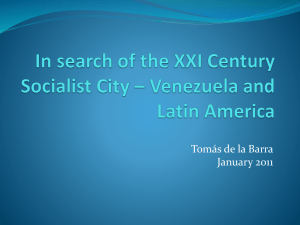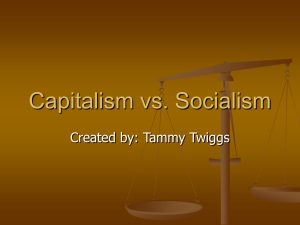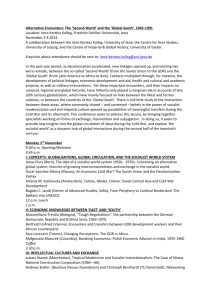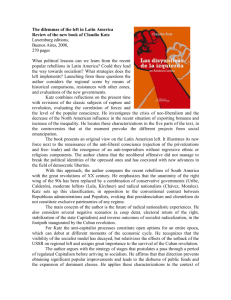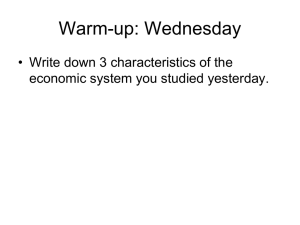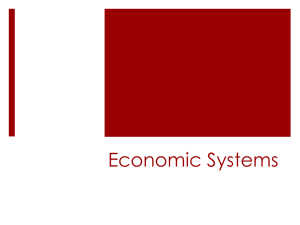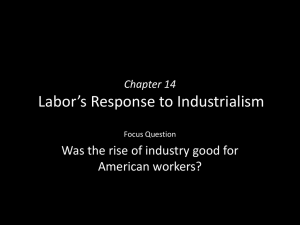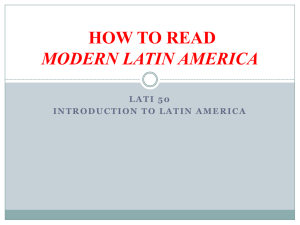Strategies of the Left in Latin America
advertisement
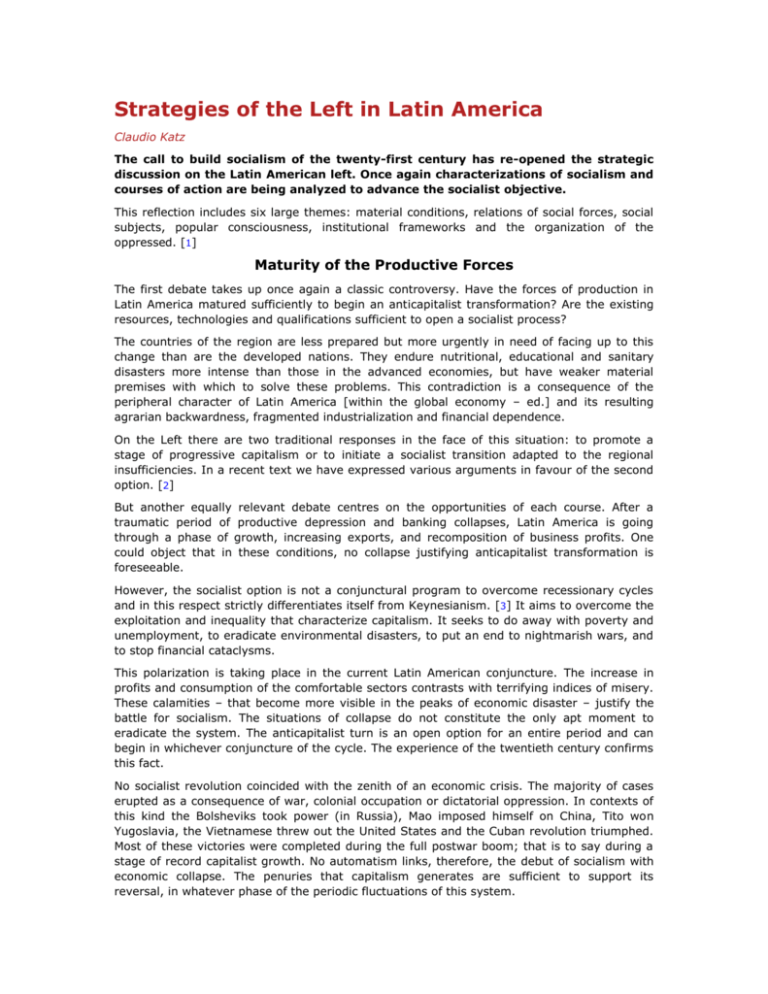
Strategies of the Left in Latin America Claudio Katz The call to build socialism of the twenty-first century has re-opened the strategic discussion on the Latin American left. Once again characterizations of socialism and courses of action are being analyzed to advance the socialist objective. This reflection includes six large themes: material conditions, relations of social forces, social subjects, popular consciousness, institutional frameworks and the organization of the oppressed. [1] Maturity of the Productive Forces The first debate takes up once again a classic controversy. Have the forces of production in Latin America matured sufficiently to begin an anticapitalist transformation? Are the existing resources, technologies and qualifications sufficient to open a socialist process? The countries of the region are less prepared but more urgently in need of facing up to this change than are the developed nations. They endure nutritional, educational and sanitary disasters more intense than those in the advanced economies, but have weaker material premises with which to solve these problems. This contradiction is a consequence of the peripheral character of Latin America [within the global economy – ed.] and its resulting agrarian backwardness, fragmented industrialization and financial dependence. On the Left there are two traditional responses in the face of this situation: to promote a stage of progressive capitalism or to initiate a socialist transition adapted to the regional insufficiencies. In a recent text we have expressed various arguments in favour of the second option. [2] But another equally relevant debate centres on the opportunities of each course. After a traumatic period of productive depression and banking collapses, Latin America is going through a phase of growth, increasing exports, and recomposition of business profits. One could object that in these conditions, no collapse justifying anticapitalist transformation is foreseeable. However, the socialist option is not a conjunctural program to overcome recessionary cycles and in this respect strictly differentiates itself from Keynesianism. [3] It aims to overcome the exploitation and inequality that characterize capitalism. It seeks to do away with poverty and unemployment, to eradicate environmental disasters, to put an end to nightmarish wars, and to stop financial cataclysms. This polarization is taking place in the current Latin American conjuncture. The increase in profits and consumption of the comfortable sectors contrasts with terrifying indices of misery. These calamities – that become more visible in the peaks of economic disaster – justify the battle for socialism. The situations of collapse do not constitute the only apt moment to eradicate the system. The anticapitalist turn is an open option for an entire period and can begin in whichever conjuncture of the cycle. The experience of the twentieth century confirms this fact. No socialist revolution coincided with the zenith of an economic crisis. The majority of cases erupted as a consequence of war, colonial occupation or dictatorial oppression. In contexts of this kind the Bolsheviks took power (in Russia), Mao imposed himself on China, Tito won Yugoslavia, the Vietnamese threw out the United States and the Cuban revolution triumphed. Most of these victories were completed during the full postwar boom; that is to say during a stage of record capitalist growth. No automatism links, therefore, the debut of socialism with economic collapse. The penuries that capitalism generates are sufficient to support its reversal, in whatever phase of the periodic fluctuations of this system. One objection to starting socialist processes highlights the impediments created by globalization. It is argued that the current internationalization of capital makes an anticapitalist challenge in Latin America impractical. But where exactly is the obstacle? Globalization does not constitute a barrier for a project of universal scope, such as socialism. The overflowing of borders extends the imbalances of capitalism and creates better objective bases for a socialist transformation. The presentation of globalization as a stage that makes alternative models impossible is a tributary of the neoliberal vision which proclaimed the inexistence of alternatives to the rightist model. But if one discards socialism for this reason it is also necessary to reject whatever Keynesian or regulated capitalist alternative. It is inconsistent to argue that the totalitarianism of globalization has buried the anticapitalist project, but tolerates interventionist forms of accumulation. If it has shut out all options for socialism there are also no openings for neo-developmentalism. However, in reality globalization does not constitute the end of history and all alternatives remain open. It is merely that a new period of accumulation began, sustained by the recomposition of profits at the expense of the oppressed and by transfers of major international imbalances to the weakest economies. These regressive media give new life to the necessity of socialism as the only popular response to the new stage. It is the only exit which can remedy the instabilities created by the expansion of global capital in a framework of nation states, and in the face of tensions generated by the overflowing of financial speculation, imperialist polarization and the divorce between markets and technological advance. What is the Correlation of Forces? The pre-eminence of relations of forces favourable to the oppressed is a condition for socialist change. The popular majority cannot prevail over its antagonists of the dominant classes if it faces a very negative balance of power. But how do we assess these parameters? The correlation of forces is determined in Latin America by the positions gained, threatened or lost by three sectors: the local capitalist classes, the oppressed masses and American imperialism. During the 1990s a massive global offensive of capital over labour was consummated on a global scale. The initial Thatcherite forcefulness of this broadside has decreased, but it left behind an adverse general climate for workers on an international scale. What happened in Latin America? The capitalists of the region actively participated in this attack, but ended up suffering various collateral consequences from the process. With commercial opening they lost their competitive positions and with the de-nationalization of the productive apparatus they gave up their defences against their external competitors. Later, the financial crisis thrashed the establishment and took away their direct political presence. As a consequence the right has been left in a minority and centre-left governments replaced many conservatives in the management of the state (especially in the Southern Cone). [4] The capitalist elite are no longer able to fix the agenda of the entire region with impunity. They have been affected by a crisis of neoliberalism that could result in the structural decline of this project. The regional relation of forces has also been modified by massive popular uprisings, which in South America precipitated the fall of various heads of state. The rebellions in Bolivia, Ecuador, Argentina and Venezuela have had direct repercussions on the dominant classes as a whole. They challenged business aggression and in many countries imposed a certain accommodation with the masses. The combative impulse is very unequal. In certain nations popular protagonism is visible (Bolivia, Venezuela, Argentina, Ecuador), while in others an ebb in the tide prevails as a consequence of deception (Brazil, Uruguay). A new development is the awakening of worker and student struggles in countries that lead in neoliberal ranking (Chile), and in nations overwhelmed by social abuses and haemorrhages of migration (Mexico). The correlation of forces is extremely varied in Latin America, but a general trend of popular initiatives is reaffirming itself throughout the entire region. At the beginning of the 1990s American imperialism launched a politics of recolonization in its backyard through free trade and the installation of military bases. This panorama has also changed. The original version of the Free Trade Area of the Americas (FTAA) failed because of conflicts between globalized and dependent corporations in internal markets, clashes between exporters and industrialists and extensive popular rejection of the project. The counteroffensive of bilateral trade agreements that the US Department of State has launched does not compensate this setback. The international isolation of Bush (electoral collapse of the Republicans, failure in Iraq, loss of allies in Europe) has closed the space for unilateralism and spurred the resurgence of geopolitical blocs adverse to the United States (such as the Non-Aligned countries). This American retreat is sharply reflected by the absence of military responses to the challenge of Venezuela. The correlation of forces has registered, therefore, various significant changes in Latin America. The dominant classes no longer count on the neoliberal strategic compass, the popular movement has recuperated its street presence, and American imperialism has lost capacity of intervention. Diversity of Subjects The actors of a socialist transformation are the victims of capitalist domination, but the specific subjects of this process in Latin America are very diverse. In some regions indigenous communities have occupied a leading role in the resistance (Ecuador, Bolivia, Mexico) and in other areas peasants have led the resistance (Brazil, Peru, Paraguay). In certain countries the protagonists have been formal urban workers (Argentina, Uruguay) or precarious informal urban workers (Venezuela, the Caribbean, Central America). The new role of indigenous communities and the weaker role of factory unions stand out. The multiplicity of sectors reflects the differentiated social structure and political particularities of each country. However, this diversity also confirms the variety of participants of a socialist transformation. As the development of capitalism expands the exploitation of salaried work and collateral forms of oppression, the potential actors of a socialist process are all the exploited and oppressed. This role does not fall exclusively on the salaried workers who directly create business profits, but to all the victims of capitalist inequality. What is essential is the convergence of these sectors in a common battle, which unfolds around ever-changing focal points of rebellion. Victory depends on this action against an enemy who dominates by dividing the popular camp. In this struggle certain segments of salaried workers tend to play a more central role because of the place they occupy in the vital branches of the economy (mining, factories, banks). Capitalists profit from the privations of all the dispossessed, but their profits depend on the direct labour force of the exploited and from profit which is made specifically from certain activities. This centrality is verified in the current conjuncture of economic revival, which tends to recreate the significance of salaried workers. In Argentina unions are reclaiming their preeminence in the streets, in comparison with the role played by the unemployed and the middle class during the crisis of 2001. In Chile the strikes of the miners are playing a leading part, in Mexico certain unions are establishing a role, and in Venezuela the centrality of the petroleum workers since their battle against the coup attempt (in 2002) persists. Problems of Popular Consciousness The eradication of capitalism is a project entirely dependent upon the level of consciousness of the oppressed. Only these convictions can direct a process of popular struggle toward socialism. The primitive vision of this development as an inevitable transformation of history has lost intellectual consensus and political attractiveness. No pattern of historical evolution of this type exists. Socialism will constitute a voluntary creation of the vast majorities or it will never arise. What occurred under “real socialism” illustrates how terrible it is to substitute popular determination with the paternalism of functionaries. But the consciousness of the oppressed is a sphere subject to sudden changes and is conditioned by the experience of struggle. Two opposing forces influence its development: the learning that the oppressed assimilate in their resistance against capital and the dejection which is generated by stifling work, anxiety for survival and daily alienation. The inclination of salaried workers to question or accept the existing order stems from the variable results of this conflict. In certain circumstances critical vision predominates and in other moments resignation prevails. These attitudes depend on many factors and operate on very distinct generational perceptions of capitalism. For example, contrary to the 1970s the bulk of contemporary youth grew up without expectations of better jobs or education, observing exclusion, unemployment and inequality as normal facets of the functioning of the system. With this new outlook of the existing order, the new Latin American generation has taken up again the bellicosity of its predecessors. But specifically socialist consciousness does not depend only on the predominant image of capitalism. On this level conclusions drawn from the class struggle and the impact provoked by key international events are more important. These milestones determine the extent of certain “average degrees of socialist consciousness,” that translate into levels of enthusiasm toward or disillusion with the anticapitalist project. The victories achieved in Russia, China, Yugoslavia, Vietnam or Cuba brought about a positive socialist perception that was not shattered by the numerous defeats that also occurred in those periods. The current Latin American generation did not come of age as did their parents in a context marked by great triumphs. This absence of a successful anticapitalist reference – close to their immediate experiences – explains their greater spontaneous coldness toward the socialist project. The biggest differences between the current period and the era of 1960-1980 are situated more on the level of political consciousness, than on the terrain of the relationships of social forces or change in popular subjects. It is not the intensity of social conflicts, the disposition of struggle of the oppressed or capacity of control of the oppressors which has changed substantively, but rather the visibility of and popular confidence in a socialist model. The collapse of the Soviet Union caused a crisis of international credibility of the socialist project which has conditioned the action of the left. Latin America was not an exception, but the effective scope of this impact has been more limited in the region. The Latin American left had already traveled a great distance from the Soviet model before the collapse of the “socialist camp” and its dejection was due more to the inheritance left behind by the dictatorships, the failure of Sandinismo or the blockade suffered by the Central American insurgency. [5] Also on this level, the survival of the Cuban revolution functioned as a counterweight. In any case the climate of disappointment was gradually replaced by an impulse to rebuild the emancipatory program. The advance of antineoliberal consciousness is illustrated in the forceful rejection of privatizations and deregulations (much greater than that observed in other regions, such as Eastern Europe). A rebirth of anti-imperialist consciousness is also taking place without the regressive components of ethnicity or religion that prevail in the Arab world. However, the anticapitalist connection is the great missing link in this antineoliberal and antiimperialist drive. This deficiency has curbed until now the radicalization of popular consciousness and therefore it is important to debate the socialism of the twenty-first century, a discussion initiated by the Bolivarian process (in Venezuela). This ideological reconstruction is possible because of the presence of many features of continuity on the left, which has suffered fewer fractures than in other regions. Neither the collapse of the historic political identity of the workers or the distancing from the left that occurred in various Eastern European countries is notable. The Constitutional Framework The Latin American left faces a relatively new strategic problem: the stabilization of constitutional regimes. For the first time in the history of the region the dominant classes manage their governments through non-dictatorial institutions, in almost all the countries and after a significant period. Neither economic collapses or political crises or popular insurrections altered this form of government. The return of the military is for the most part a discarded hand for the hemisphere’s elites. In the most critical situations presidents are replaced by other leaders with some type of civicmilitary interregnum. What is discarded for now is the reinstallation of dictatorships to fight fragmentation from above or rebellion from below. The current regimes are not real democracies but rather plutocracies in the service of capitalists. The institutions of this system have served to perpetuate social abuses which many dictatorships would not even have dared to suggest. These aggressions diminished the legitimacy of the system, but did not lead to a popular rejection of the constitutional regime equivalent to that suffered by the old tyrannies. This change in the rule of capitalist domination has contradictory effects on the action of the Latin American left. On the one hand it amplified the possibilities of political action in a context of public freedoms. On the other hand the stabilization of parliaments, parties and functionaries offered capitalists more political security and growing confidence in their business affairs. A system which reduces and at the same time consolidates the power of the oppressors represents a great challenge for the left, especially when this regime is for the most part perceived as the natural mechanism for the functioning of any modern society. This last belief is encouraged by the right – which has grasped the usefulness of conducting their political activity within the constitutional context – and by the centre-left – which preserves the status quo under progressive masks. Both stoke false electoral polarizations in order to present the simple alternation of figures in power as meaningful change. The current example of this complementariness is the “modern and civilized left” that arrived in government with Lula (Brazil), Tabaré (Uruguay) or Bachelet (Chile), in order to perpetuate the supremacy of the capitalists. However, other situations are more problematic because institutional continuity was broken with fraud (Calderón in Mexico) or presidential resignations (Bolivia, Ecuador, Argentina). In certain denouements these convulsions concluded with the reconstruction of the bourgeois order (Kirchner in Argentina), but in other countries the crisis resulted in the unexpected entrance to government of nationalist or reformist presidents, who are rejected by the establishment. This is the case of Chávez (Venezuela), Morales (Bolivia) and probably Correa (Ecuador). These results have been the consequence of the non-institutional character the crises and insurrections in these nations initially assumed. In these processes the electoral terrain has shaped up to be an area of struggle against reaction and a point of support for coming to terms with radical transformations. This conclusion is vital for the left. For example, since 1998 all of the elections deepened the legitimacy of the Bolivarian process in Venezuela and transferred to the ballot box the defeat dealt to the right in the streets. The electoral sphere and the victories of mobilization complemented one another. The constitutional setting significantly altered the framework of action of the left, which for decades had been accustomed to confronting a dictatorial enemy. The battle within these systems is not easy because institutionalism functions with permanent pretences of reproducing the existing order. Therefore it is necessary to combine direct action with electoral participation. For this path, times of arising popular power – which every revolutionary process requires – and the maturation of socialist consciousness – which to a certain degree is processed through the constitutional arena – complement one another. Movements and Parties Popular consciousness translates into organization. The grouping together of the oppressed is indispensable to creating instruments of an anticapitalist transformation, since without their own organisms the exploited cannot initiate an alternative project for society. Movements and parties constitute two modalities of contemporary popular organization. Both options perform an essential role for the development of socialist convictions. They reinforce confidence in self-organization and develop bases of collective functioning of popular power for the future. Movements sustain immediate social struggle and parties fuel more developed political activity. Both instances are necessary to facilitate direct action and electoral participation. However, this complementariness is frequently questioned. There are exclusive advocates of movements and of parties. But these objections only invalidate the actions of certain parties and not the general function of these structures, which are irreplaceable for acting on the political level. No emancipatory project can progress exclusively on social terrain, or dispense with the specific platforms, the links between demands and strategies of power, which party organizations provide. These groupings contribute to overcoming the limitations of a spontaneous rebellion. The party facilitates the maturation of an anticapitalist consciousness, which does not emerge abruptly from protest action and which requires differentiating struggle for improvements under capitalism and the battle for socialist objectives. The disqualification organizations on the iron verticalism and organization leads to of parties is as inadequate as the vice of superiority that some left still exhibit. They maintain the old vanguardist conception, act with reward themselves with permanent self-proclamation. This cult of the sectarian practices and a quest for hegemony in all social movements. This form of political action feeds itself from the small-group caudillista tradition, or the tradition of strong-man, top-down leadership. In some countries this behaviour also expresses persistent bad habits from an organizational culture built during decades of clandestine action and antidictatorial resistance. In the current framework of public freedoms and party competition the confused character of this conduct is patently obvious. Those who maintain these practices can thrive, but they will never lead a socialist transformation. Reform and Revolution Material conditions, correlation of forces, social subjects, popular consciousness and popular organization shape the hexagon of themes that surround the strategy of the left. The postulated programs connecting action, conviction and proposals in a socialist sense depend on these six foundations. However, rarely are these components coincidental. Sometimes the maturity of material conditions does not converge with the correlation of forces, with the protagonism of social subjects or with the aptitude of the political context. Less common still is the connection of these elements with the level of organization, consciousness and popular leadership required for an anticapitalist project. The strategy of the left is a search for paths to overcome these discordances and the analytical distinction of six great questions aiming to facilitate this analysis. The biggest problem is situated in the links that connect these pillars. The routes to follow are extremely varied because the universalism of the socialist program is not synonymous with uniformity. The experience of the twentieth century has illustrated how the bases of this process combine together in differentiated forms in each country. It has also been confirmed that the temporary nature of a socialist debut differs significantly between accelerated insurrectional conclusions (Russia) and prolonged confrontations of dual power (China, Vietnam). [6] There are two grand responses – traditionally counterposed – to the dilemmas created by this disconnect between components of socialist change: reform and revolution. The first path promotes combining the disarticulated elements through a progression of social improvements that reinforce the positions of the workers and consolidate their political weight, institutional presence and organizational force. But these reforms – which are feasible under capitalism – do not accumulate and are not irreversible. Sooner or later their consolidation (or deepening) clashes with the rule of profit and suffers employers’ abuse which provokes major conflicts. In these circumstances the consequent popular response demands advancing toward socialist change. Reforms are only valid as a link in the struggle for socialism. The absence of this perspective leads to the abandonment not only of an anticapitalist future, but of the improvements themselves. It’s incorrect to attempt first the “resolution of immediate problems” in order to “discuss socialism later.” If capitalism could structurally solve those problems socialism would be unnecessary. The second idea of socialist change promotes revolution and rejection of reforms. It calls for overcoming the disconnection between objective and subjective conditions through action which articulates the peaks of the crisis of capitalism with the disposition of struggle of the masses and socialist convictions. However, this connection is not so easy, even when there occur conjunctures close to the Leninist model of a revolutionary situation (“those from above can no longer continue dominating and those from below play a leading role in a historical eruption”). In South America we have observed in the last several years various circumstances of this type without any socialist result. Crisis of hegemony or authority of the dominant classes (loss of consensus and leadership capacity in Gramscian terms) converging with the revolt of the subaltern classes is not enough. [7] Socialist maturity requires a prior process of learning which is not improvised in the expeditious path toward power. That preparation includes social achievements and democratic conquests that are obtained through reforms. This last term is not a bad word, nor is it situated in the antipodes of revolution. It is a useful instrument to gradually develop the revolutionary leap forward, building bridges which move the oppressed closer to the socialist goal. A combination of reform and revolution can enable the link between immediate conquests and radical ruptures with capitalism. The first type of achievement is indispensable for creating popular power and the second for defeating an enemy that will not renounce its privileges. To connect reform with revolution is the way to adapt the correlation of forces and popular action with the possibilities of anticapitalist transformation in each country. But it is necessary to replace the old counterposing of both roads with their confluence. Optimism and Reason To discuss strategies presupposes searching for a guide for inspired action in past experiences, but always remaining open to new circumstances and experiences. This inquiry includes unprecedented hypotheses and no simple calculus of models to repeat. The strategy of the left includes a liberated dimension that cannot be found in other political formations. It raises humanist objectives associated with a communist horizon which no bourgeois current can offer. But the credibility of these goals depends on the behaviour of its organizers and this conduct presupposes an attitude of spontaneous resistance to inequality and intuitive rejection of injustice. The function of strategy is to transform indignation in the face of misery and solidarity with the oppressed into rational projects. And this development demands intellectual bravery to face up to the thorniest and most unpleasant problems. If there is no disposition to tackle the difficulties, the roads to socialism will invariably remain blocked. The current Latin American conjuncture invites renewing strategic controversies on the left with frank, open and respectful debates. It is the moment to adopt the achievements and weigh the limitations with an enthusiastic and critical attitude. Both positions contribute to forging reasoned optimism which the battle for socialism demands. Claudio Katz teaches at the University of Buenos Aires and is involved in the Argentine network ’Economistas de Izquierda’ (EDI, ’Left Economists’). NOTES [1] This is a challenging theoretical text available for the first time in English. Claudio Katz’ interventions in the thriving debates on the future of socialism in Latin America have been much discussed in the magazines, journals and websites of the left throughout Latin America and Spain. In providing a translation of Katz’ most recent contribution New Socialist is attempting to introduce to North American readers a taste of the character of discussions around building a socialism for the twenty-first century currently taking place on the ground in Latin America. The editors added the explanatory footnotes to the original text. Claudio Katz is an economist at the University of Buenos Aires, a researcher with Conicet, and a member of Economistas de Izquierda, Economists of the Left, in Argentina. This article was translated by New Socialist editor Jeffery R. Webber and appears in issue 61 (Summer 2007) of New Socialist www.newsocialist.org [2] Claudio Katz, “Socialismo o Neo-desarrollismo,” (Socialism or Neo-Developmentalism), available in Spanish at: www.lahaine.org, 1-12-06, or www.rebelion.org, 1-12-06. [3] Keynesianism refers to the reformist economic theory of John Maynard Keynes. It was most influential between the end of the Second World War and the 1970s. [4] The Southern Cone refers to Argentina, Chile, Paraguay and Uruguay. [5] Sandinismo refers to the ideology and practice of the Sandinista revolutionary government of Nicaragua, in power between 1979 and 1990. The Central American insurgencies referred to here were the unsuccessful revolutionary guerrilla wars waged in Guatemala and El Salvador in the 1980s. [6] Dual power refers to an unstable and unsustainable period of a revolutionary situation in which popular institutions of the exploited and oppressed emerge alongside and in opposition to the existing institutions of the state. [7] Antonio Gramsci was an Italian Marxist who developed the most influential Marxist theory of hegemony.

